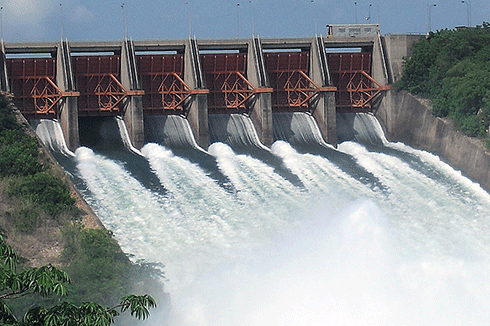
|
Published: 5 November 2014
World’s hydropower boom may swamp rivers and biodiversity
Hydropower dam development and construction is booming, primarily in developing countries and emerging economies. While this is expected to double the global electricity production from hydropower, it could also reduce the number of our last remaining large free-flowing rivers by about 20 per cent and pose a serious threat to freshwater biodiversity, according to a European study.

|
|
Akosombo Dam spilling water, Ghana. Credit:
ZSM CC BY-SA 3.0
|
‘Hydropower is an integrated part of transitioning to renewable energy and currently the largest contributor of renewable electricity,’ said University of Copenhagen’s Professor Christiane Zarfl who, with colleagues, carried out the study at Berlin’s Leibniz-Institute of Freshwater Ecology and Inland Fisheries (IGB).
‘However, it is vital that hydropower dams do not create a new problem for the biodiversity in the world's freshwater systems, due to fragmentation and the expected changes in the flow and sediment regime.
‘That is why we have compiled available data on future expected hydropower dams – to form a key foundation for evaluating where and how to build the dams and how to operate them sustainably.’ The new database is designed to support decision-making on sustainable modes of electricity production.
Renewables account for 20 per cent of the global electricity production, with hydropower contributing 80 per cent of the total share. An expected 3700 major dams may more than double the total electricity capacity of hydropower to 1700 gigawatts (GW) within the next two decades.
If all planned dams are constructed, China will remain the global leader in hydropower dam construction, although its share of total future global hydropower production will decline from the current 31 per cent to 25 per cent, due to increased construction in other parts of the world.
The Amazon and La Plata basins in Brazil will have the largest total number of new dams in South America, whereas the Ganges-Brahmaputra basin (mainly in India and Nepal) and the Yangtze basin in China will face the highest dam construction in Asia.
‘When building new dams, it is important to follow a systematic management approach that considers the ecological, social, and economic consequences of multiple dams within a river basin,’ said Prof Klement Tockner, head of IGB, who is leading the Institute´s research activities on sustainable hydropower development.
‘We expect to launch the database in BioFresh, the platform for global freshwater biodiversity (research and policy), and hope to see our results as a valuable reference basis for scientists and decision makers in supporting sustainable hydropower development,’ added Prof Zarfl.
Source: University of Copenhagen



